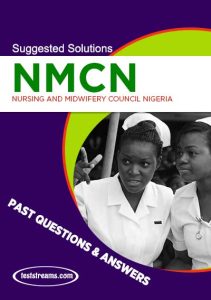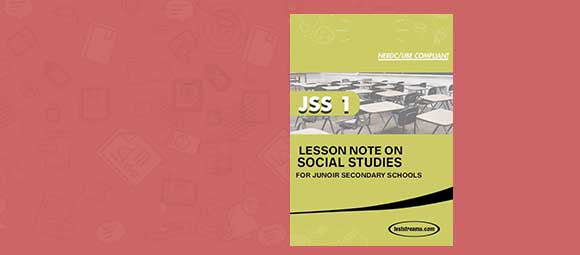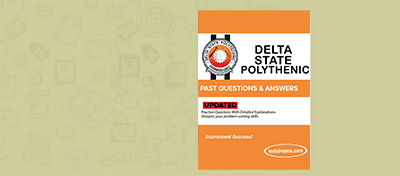The FCT School of Nursing Gwagwalada Past Questions and Answers has been compiled from past years aptitude test exams conducted by the FCT School of Nursing Gwagwalada. We have taken time in solving the questions contained in these past question papers with the most appropriate answers, meaning you won’t have to spend time searching for the correct answers.
We have worked tirelessly to get the best and up-to-date copy of the FCT School of Nursing Gwagwalada Past Questions and compile them into one pdf file and we would advice you to follow strictly the instruction provided on this page.
Past questions can help students determine which areas they are strong with and where they need help. It is also helpful in a sense that it can help students think on how they can understand tricky questions and plan how they will answer correctly.
How is This FCT School of Nursing Gwagwalada Patterned?
We have made it simple for you. we bring all the questions which is usually in objective format. We have put them together but we indicate the specific years for every question and the correct answers in order to save your time. All you need to do is to devote quality time to study the Past Questions.
Free Sample questions from FCT School of Nursing Gwagwalada Past Questions
SECTION B: OBJECTIVE QUESTIONS (40%)
Answer all Questions
Time allowed: 3 hours
INSTRUCTIONS:
The following are Objective Test Items. CIRCLE the appropriate OPTION with BIRO.
Each question counts for ONE (1) mark.
This booklet MUST be attached to the Essay Answer Script
Enter your NUMBER on this booklet.
1.One of the following is NOT among the branch of microscope anatomy:
(a) Organology.
(b)Topographical anatomy.
(c)Histology.
(d)Cytology.
2.The vertebral column consists of…………………….irregular bones.
(a)26
(b)24
(c)20
(d)15
3.The term used to describe the longitudinal imaginary division of the body into two equal part (right and left) when the body is in anatomical position is known as:
(a)saggital or para-saggital plane.
(b)median or mid-saggital plane.
(c)frontal or coronal plane.
(d)transverse or horizontal plane.
4.The threadlike or lozonge-shaped membraneous organelles found in somatic cell is called:
(a) Ribosomes.
(b) Plasma membrane.
(c) Mitochondria.
(d) Nucleus.
5.One of the following is a characteristic sign of shock in myocardial infarction:
(a) Oliguria.
(b) Bradycardia.
(c) High blood pressure.
(d) Hyperthermia.
6. The most important stakeholder in the health care system is the:
(a) Nurse.
(b) Medical doctor
(c) Patient.
(d) Pharmacist.
7. In cell division, the period from cell formation to cell division is referred to as
(a) GI (gap one) phase.
(b) Interphase.
(c) Sub phase.
(d) GII (gap two) phase.
8. The replacement of destroyed tissue with the same kind of tissue is called:
(a) scar tissue formation.
(b) fibrosis.
(c) regeneration.
(d) scar formation.
9. One of the following is contraindicated in a patient with gout.
(a) Liver.
(b) Chocolate
(c) Green leafy vegetables.
(d) Egg
10. Which of the following should the nurse administer to meet the nutritional needs of a patient with acute peritonitis?
(a) Parenteral feeding.
(b) Oral feeding.
(c) Gastro enteral feeding.
(d) Nasogastric feeding.
11. The oesophagus is made up of………………………….layers.
(a) 4
(b) 3
(c) 2
(d) 5
12. A break in the structure of the continuity of bone is called:
(a) Dislocation
(b) Sprain.
(c) Strain.
(d) Fracture.
13. One of the following is NOT a risk factor for lower back pain.
(a) Weight loss.
(b) Weight gain.
(c) Repetitive lifting of heavy objects.
(d) Poor posture.
14. The stomach is bounded by all of the following organs SUPERIOLY EXCEPT
(a) Left lobe of the liver.
(b) Spleen.
(c) Oesophagus.
(d) Diaphragm.
15. The auricle and pinna constitute………………..part of the ear.
(a) external
(b) middle
(c) internal
(d) cochlea.
16………………….is a structure that connects a bone to another bone.
(a) Tendon
(b) Cartilage
(c) Muscle
(d) Ligament
l7. Which of the following terms describe degenerative joint disease?
(a) Osteoporosis.
(b) Osteomyelitis,
(c) Osteoarthritis.
(d) Osteomalacia.
18. The movement of body towards the midline is called:
(a) Abduction.
(b) Induction.
(c) Adduction.
(d) Circumduction.
19. All of the following are examples of cartilage tumor EXCEPT
(a) Osteochondroma.
(b) Periosteal chondroblastoma.
(c) Enchondroma.
(d) None of the above.
20. The most dilated portion of the gall bladder is the
(a) Body.
(b) Neck.
(c) Fundus.
(d) Cystic duct.
21. The first step in assessment is
(a) Review of past records.
(b) Physical examination.
(c) History taking.
(d) Counselling.
22. All the following are techniques of physical examination EXCEPT
(a) Inspection.
(b) Palpation.
(c) Classification.
(d) Auscultation.
23. The first stage in stress response is
(a) stage of resistance.
(b) stage of alarm reaction.
(c) stage of exhaustion.
(d) stage of flight
24. The following are steps of pain reception EXCEPT
(a) pain trasduction.
(b) pain transmission.
(c) pain perception.
(d) pain modulation.
25…………… ………is an example of hypertonic saline.
(a) 3% sodium chloride
(b) 0.9% sodium chloride
(c) 5% Dextrose
(d) 50% Dextrose
26 …………………..is a clinical sign of elevated prothrombin time.
(a) Oedema
(b) Ecchymois
(c) Jaundice
(d) Pruritis
Remember that procrastination is a thief of time Get the Full NMCN Entrance Exams Questions And Answers PDF- PDF Download, with even more questions and answers



